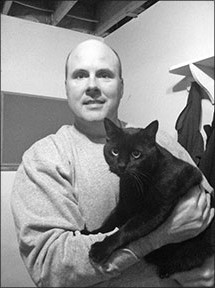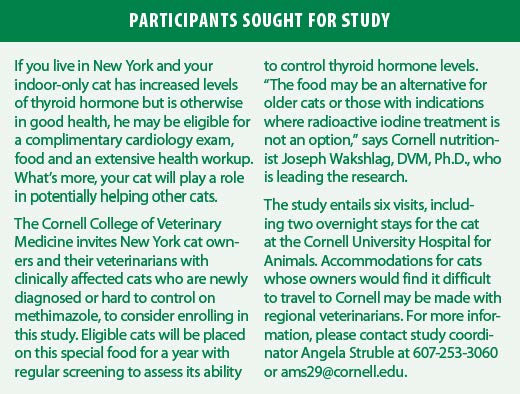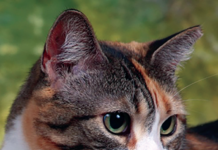Today’s treatments of choice for hyperthyroidism are often quick and effective, but can also have their downsides. Radioiodine therapy — a safe injection of radioactive iodine — has cure rates as high as 98 percent with one treatment.

288
It’s the gold standard, says nutritionist Joseph Wakshlag, DVM, Ph.D., Associate Professor at the Cornell College of Veterinary Medicine, because it basically destroys the epithelial cells that make thyroid hormone.
The challenge is that radioiodine’s availability is limited to clinics and hospitals like Cornell that have permits to use radioisotopes. Another disadvantage is that the cat must be hospitalized for a few days until the radioactive iodine clears his body.
Lifetime Medicine. Methimazole, an affordable medication, is another treatment option. It is readily available but may require lifelong administration, along with regular exams to monitor dosage. Some patients develop side effects such as itching, rashes and loss of appetite. In addition, Dr. Wakshlag says, “Cats are masters of getting away from pills.”
Surgery to remove a hyperactive thyroid gland is another treatment option, but it’s invasive, requires anesthesia and, like any operation, can lead to complications.
Dr. Wakshlag is pursuing a nutritional option — a therapeutic diet for hyperthyroidism already on the market — to see if it can help seriously affected cats. After he learned that Hill’s Pet Nutrition Prescription Diet y/d Feline Thyroid Health food brought its colony cats’ thyroid hormone levels down to normal ranges, Dr. Wakshlag asked the company if pet cats with difficult cases could improve on the diet. The company made him an offer: You research the food on pet cats, and we’ll provide funding for the study.

288
Now Dr. Wakshlag is recruiting pet cats with hyperthyroidism through June for his research. Five cats already under study have stabilized or gained weight after being on the diet for more than six months, and he’s seeking 15 more. “Early results in some cats severely affected with extremely high thyroid concentrations are promising,” Dr. Wakshlag says. “It’s been very, very encouraging for the five.”
All of the cats are enjoying a mix of wet and dry food. The dry cat food is 36 percent protein, 25.7 percent fat, 28.6 percent carbohydrate. The canned is 34 percent protein, 25.9 percent fat, 31.4 percent carbohydrate. Both foods are restricted in iodine to the minimum requirement for cats established by Hill’s feeding studies.
The prevalence of hyperthyroidism in cats has significantly increased since it was first reported in the 1970s. Estimates are that more than 10 percent of older cats will develop the disease. It’s now recognized as the most common feline endocrine disorder worldwide, according to a study published in the Journal of Feline Medicine and Surgery.
Undetermined Causes. The cause of hyperthyroidism, an excess of hormone production by thyroid glands in the cat’s neck, is unknown, though many factors likely are involved. For example, the journal study suggests lifelong environmental exposure to thyroid-disrupting chemicals in food or water may set the stage.
Signs of hyperthyroidism include weight loss despite a voracious appetite, thinning of the coat, anxiety and increased vocalization. Cats with hyperthyroidism may also develop thickening of the left ventricle of the heart. If left untreated, the changes can result in heart failure.
“The consequences of hyperthyroidism are quite severe,” Dr. Wakshlag says. “Cats lose tremendous amounts of body weight. They develop cardiac problems, but it’s 100 percent treatable. Although we have treatments for this disease, they don’t meet the needs of every cat due to the nature of delivery or to geographic location. This new dietary approach appears to be a safe, easy and effective treatment option for owners with cats who have uncomplicated hyperthyroidism — no concurrent kidney issues, which can be common for cats with hyperthyroidism.” ❖



